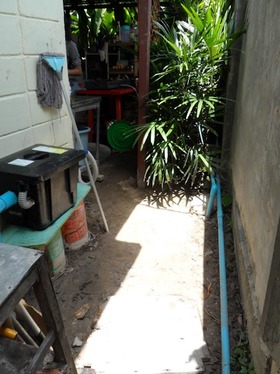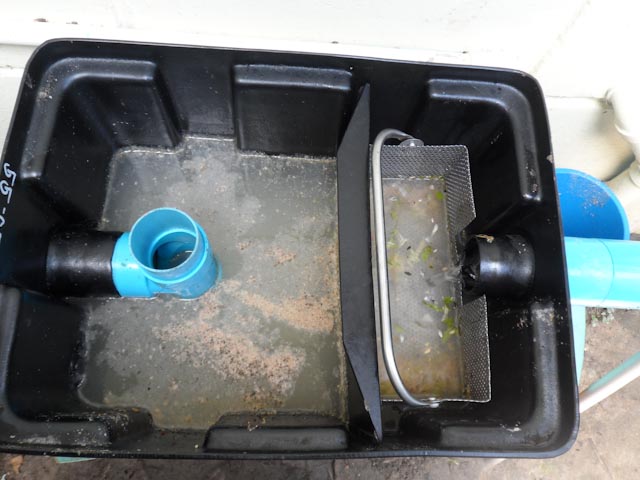Maintainance, evaluation and perhaps some tweaking..
Everything in the garden has been designed to be pretty straightforward to maintain. The plants are all easy to take care of, needing nothing more than some watering. We have given the Free Bird cafe a copy of the garden design so Lisa and the staff can see what is planted where. We are also in the process of preparing a booklet of information about the new plants, giving details of how to identify them and care for them should they develop any common problems.
The water system was the only thing that on the day needed some slight adjustments. We thought it may as it was a very experimental design for us, and we weren't sure that it was going to work as planned.
When we first tried it out we faced a problem that the water was all coming out of the holes in the drainage pipe too soon - none of the water was reaching the far end of the pipe, and due to a slight slope on the muddy ground near the box the water was finding it's way back down to the alleyway behind the house before it had a chance to soak into the ground. This is the same place that flooded before the filter box was in place, so was a terrible outcome! We realised that we could solve this by changing the filter pipe with another that had fewer holes, and that it would be better to only have the holes starting from halfway down the pipe, so that the water would be unable to exit the pipe so close to the sloping ground.
Just to be sure, we also created a 90 degree bend in the exit pipe so that the water would then be persuaded to travel down to the end of the pipe by gravity. We also changed the exit pipe to a smaller diameter tube, so that the pressure of the leaving water would be increased. We dug a large hole at the very end of the pipe where the last of the water would finally exit, and filled this hole with pebbles. This would stop the ground becoming waterlogged and muddy and would allow easy filtration of the water into the land. You can see these adjustments below. ,
The water system was the only thing that on the day needed some slight adjustments. We thought it may as it was a very experimental design for us, and we weren't sure that it was going to work as planned.
When we first tried it out we faced a problem that the water was all coming out of the holes in the drainage pipe too soon - none of the water was reaching the far end of the pipe, and due to a slight slope on the muddy ground near the box the water was finding it's way back down to the alleyway behind the house before it had a chance to soak into the ground. This is the same place that flooded before the filter box was in place, so was a terrible outcome! We realised that we could solve this by changing the filter pipe with another that had fewer holes, and that it would be better to only have the holes starting from halfway down the pipe, so that the water would be unable to exit the pipe so close to the sloping ground.
Just to be sure, we also created a 90 degree bend in the exit pipe so that the water would then be persuaded to travel down to the end of the pipe by gravity. We also changed the exit pipe to a smaller diameter tube, so that the pressure of the leaving water would be increased. We dug a large hole at the very end of the pipe where the last of the water would finally exit, and filled this hole with pebbles. This would stop the ground becoming waterlogged and muddy and would allow easy filtration of the water into the land. You can see these adjustments below. ,
We returned to the cafe one week after the implementation had taken place, to check everything was running smoothly and to see if Lisa was having any problems. We found her to be completely happy with the way everything was going, and really enjoying her new garden. She had had some very positive comments from students who were very excited to see the changes, and she and her staff were very happy to have a working water filter, saving them so much time after previously mopping and sweeping the water behind the house. In the days after we had visited the children had begun painting the mural on the wall. Here is a selection of photos from the visit one week later.
Permaculture principles and ethics visited in this project
I thought here would be a good space to explore the principles of permaculture design that we visited during this project.
|
Observe and interact
|
Produce no waste
|
|
Integrate rather than segregate
|
Use edges and value the marginal
|
And to the final stage, the appendix, and reviews, click here



